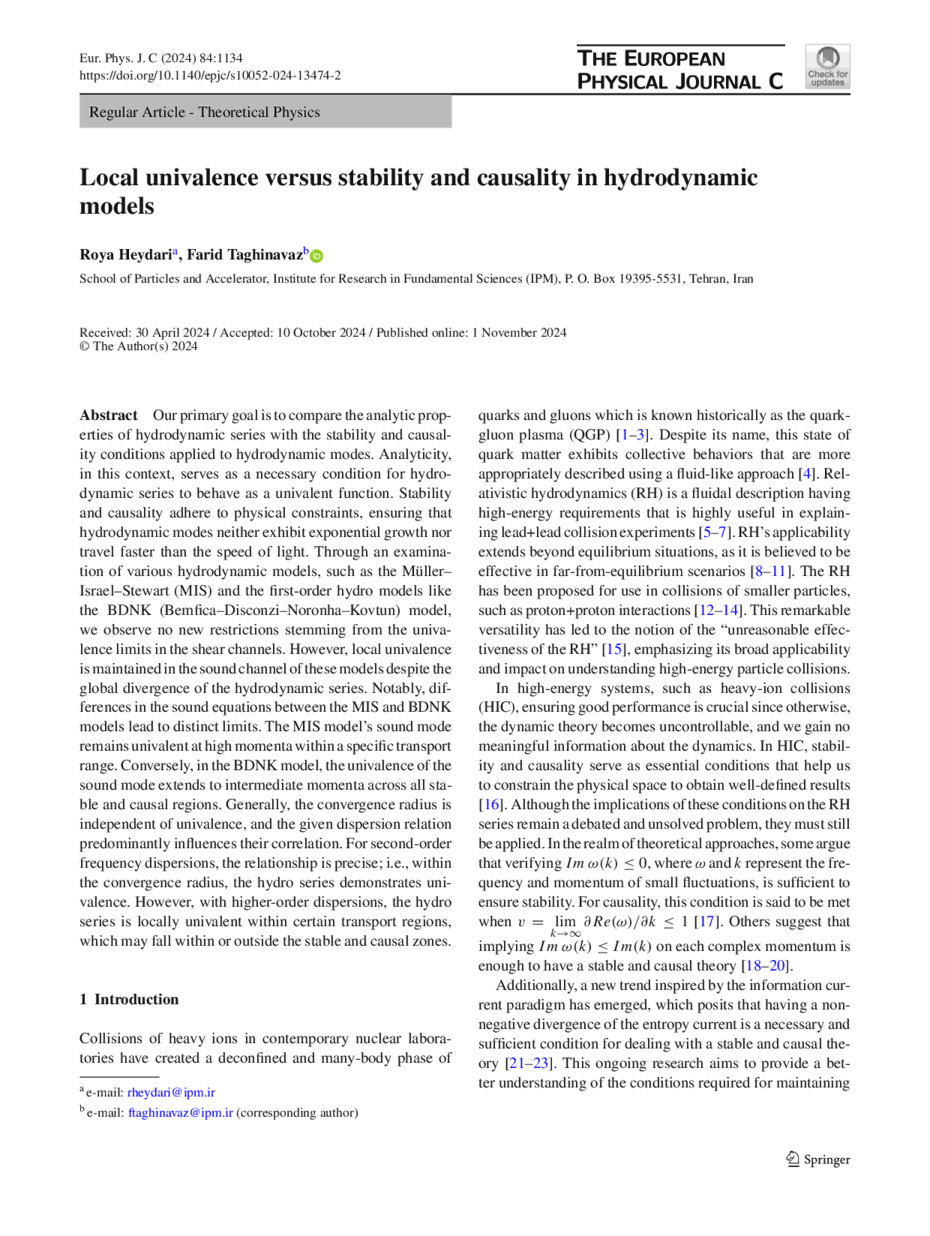https://doi.org/10.1140/epjc/s10052-024-13474-2
Regular Article - Theoretical Physics
Local univalence versus stability and causality in hydrodynamic models
School of Particles and Accelerator, Institute for Research in Fundamental Sciences (IPM), P. O. Box 19395-5531, Tehran, Iran
Received:
30
April
2024
Accepted:
10
October
2024
Published online:
1
November
2024
Our primary goal is to compare the analytic properties of hydrodynamic series with the stability and causality conditions applied to hydrodynamic modes. Analyticity, in this context, serves as a necessary condition for hydrodynamic series to behave as a univalent function. Stability and causality adhere to physical constraints, ensuring that hydrodynamic modes neither exhibit exponential growth nor travel faster than the speed of light. Through an examination of various hydrodynamic models, such as the Müller–Israel–Stewart (MIS) and the first-order hydro models like the BDNK (Bemfica–Disconzi–Noronha–Kovtun) model, we observe no new restrictions stemming from the univalence limits in the shear channels. However, local univalence is maintained in the sound channel of these models despite the global divergence of the hydrodynamic series. Notably, differences in the sound equations between the MIS and BDNK models lead to distinct limits. The MIS model’s sound mode remains univalent at high momenta within a specific transport range. Conversely, in the BDNK model, the univalence of the sound mode extends to intermediate momenta across all stable and causal regions. Generally, the convergence radius is independent of univalence, and the given dispersion relation predominantly influences their correlation. For second-order frequency dispersions, the relationship is precise; i.e., within the convergence radius, the hydro series demonstrates univalence. However, with higher-order dispersions, the hydro series is locally univalent within certain transport regions, which may fall within or outside the stable and causal zones.
© The Author(s) 2024
 Open Access This article is licensed under a Creative Commons Attribution 4.0 International License, which permits use, sharing, adaptation, distribution and reproduction in any medium or format, as long as you give appropriate credit to the original author(s) and the source, provide a link to the Creative Commons licence, and indicate if changes were made. The images or other third party material in this article are included in the article’s Creative Commons licence, unless indicated otherwise in a credit line to the material. If material is not included in the article’s Creative Commons licence and your intended use is not permitted by statutory regulation or exceeds the permitted use, you will need to obtain permission directly from the copyright holder. To view a copy of this licence, visit http://creativecommons.org/licenses/by/4.0/.
Open Access This article is licensed under a Creative Commons Attribution 4.0 International License, which permits use, sharing, adaptation, distribution and reproduction in any medium or format, as long as you give appropriate credit to the original author(s) and the source, provide a link to the Creative Commons licence, and indicate if changes were made. The images or other third party material in this article are included in the article’s Creative Commons licence, unless indicated otherwise in a credit line to the material. If material is not included in the article’s Creative Commons licence and your intended use is not permitted by statutory regulation or exceeds the permitted use, you will need to obtain permission directly from the copyright holder. To view a copy of this licence, visit http://creativecommons.org/licenses/by/4.0/.
Funded by SCOAP3.





